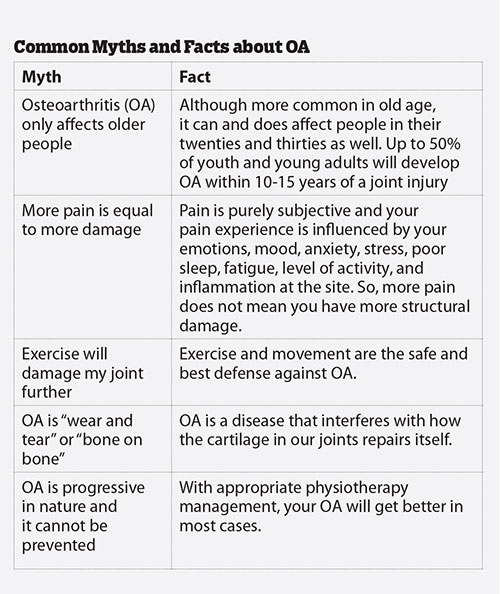World Physiotherapy Day is observed across the globe on 8th September every year. The day highlights the versatility of the profession in healthcare and the significant contributions the profession has made toward healthcare and universal healthcare coverage in the last and current centuries.
Every year the Day is celebrated and observed with a Theme that’s relevant to the time and world – usually health conditions of common public health concern. This year’s theme is “Osteoarthritis”, a health condition that is common, painful, and disabling but manageable.

Osteoarthritis (OA) is a degenerative disease that affects the tissues of the joints including cartilage, bones, ligaments, and muscles. It is the most common type of arthritis which affects any moveable joints in our body. It usually affects large joints, knees being the most common (60%), followed by hips and hands. OA is characterized by dull aching (poorly localized, insidious in onset, and aggravated by activity), joint stiffness, swollen joints, joint crepitus, reduced range of motion, muscle weakness, and functional impairments.
Worldwide, over 520 million people live with OA and from 1990 to 2019 there was a 48% increase in OA cases. Here at Jigme Dorji Wangchuck National Referral Hospital (JDWNRH), around 30% of the people visiting Physiotherapy musculoskeletal units with complaints of lower limb pain constitute OA.
The exact cause of OA still remains unknown but some of the most common risk factors include; age, obesity, previous joint injury or joint surgery or history of overuse of joint, and genetics.
How can Physiotherapy help OA?
Exercise is medicine. Exercise and physical activity are evidence-based, safe, and first-line management strategies for OA. Physiotherapy interventions can help reduce pain, improve joint movement and stiffness, strengthen the muscles around the joint, delay or prevent joint replacement, delay and prevent joints from getting worse and improve overall function. In a nutshell, physiotherapy has proven to be cost-effective management for OA.
Physiotherapy is appropriate for all kinds of people with OA irrespective of age, the severity of symptoms, and level of disability. Physiotherapy professionals can help develop an exercise/management regime tailored to suit any individual which is both doable and achievable. Additional home program exercises are also taught to ameliorate the debilitating symptoms.
Most individuals with OA are doubtful and hesitant about their knees getting hurt or damaged more if they run or jog, but it has been proven that some bouts and weight-bearing during jogging can actually help cartilage recover and adapt to repeated exposure. More so some research suggests that recreational runners may have a lower risk of OA than those sedentary people and competitive runners.
Physiotherapy management plays a vital role both in the pre-operative and post-operative phases of joint replacement in OA cases. The physiotherapy professionals can help you prepare and get maximum benefits from surgery through a preoperative optimization regime. And also help you recover well to the optimal functional level after the surgery.
Some of the best measures to prevent oneself from getting OA is to stay physically active, maintain optimal weight and prevent unnecessary joint injuries.
Contributed by
Tshering Penjor
Physiotherapist
(JDWNRH)

